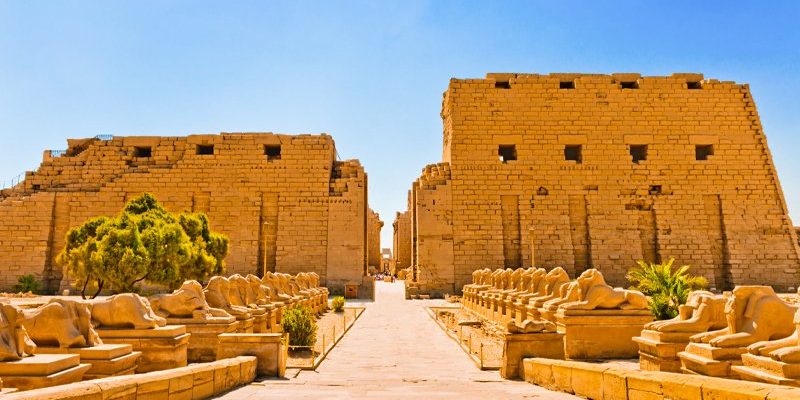Tucked along the east bank of the Nile in the ancient city of Thebes, modern-day Luxor, stands one of the most awe-inspiring testaments to Egypt’s spiritual and architectural legacy: the Karnak Temple Complex. Often overshadowed in popular imagination by the Pyramids of Giza, Karnak is in fact the largest religious structure ever built by human hands, sprawling over more than 100 hectares. It is not just a temple; it is a living archive of over 2,000 years of Egyptian history.
A City of Temples Within a City
Karnak is not a single temple, but a vast compound of shrines, pylons, sanctuaries, obelisks, chapels, and halls, each built by different pharaohs over centuries. At the heart of the complex is the Temple of Amun-Ra, the supreme god of the Egyptian pantheon during the New Kingdom. Surrounding it are smaller temples dedicated to other gods and deified rulers such as Mut (the goddess of motherhood) and Khonsu (the moon god).
Each successive pharaoh left their mark here, adding columns, gates, statues, and inscriptions that proclaimed their divine lineage and military conquests. The result is a layered masterpiece of political ambition, religious devotion, and architectural genius.
The Avenue of Sphinxes: The Processional Pathway
Your journey to Karnak typically begins with the Avenue of Sphinxes, a nearly two-mile-long processional road that once connected Karnak to Luxor Temple. Flanked on both sides by hundreds of ram-headed sphinx statues, this majestic path was the route of the Opet Festival, during which statues of the gods were paraded to Luxor Temple in a symbolic act of divine renewal.
The avenue was rediscovered and partially restored in recent years, and walking along it feels like stepping into the ceremonial life of ancient Thebes. Today, it’s a highlight of many Luxor tours, offering travelers a rare opportunity to experience the grandeur of ancient processions in one of Egypt’s most iconic cities.
The Hypostyle Hall: A Forest of Stone
Once inside the main temple, prepare to be utterly spellbound by the Great Hypostyle Hall—an architectural marvel and one of the most iconic spaces in all of Egypt. This colossal hall contains 134 towering sandstone columns, arranged in 16 rows. The central columns soar up to 21 meters (nearly 70 feet) and are adorned with vibrant hieroglyphics and images of pharaohs making offerings to the gods.
Walking through this hall, you can almost hear the echoes of ancient priests chanting hymns as sunlight filters through the narrow gaps, casting sacred shadows on the temple floor. The scale and symmetry of the Hypostyle Hall exemplify the grandeur and precision of Egyptian engineering.
Obelisks of Power and Light
No visit to Karnak is complete without gazing up at its monumental obelisks—symbolic stone spires carved from single blocks of granite and inscribed with dedications to the gods. The most famous is the Obelisk of Hatshepsut, which stands 29 meters high and weighs over 300 tons. It was constructed in just seven months—an incredible feat of logistics and craftsmanship.
These obelisks were more than decorative; they were cosmic antennae meant to channel divine energy from the heavens to the Earth. Their tips were often covered in electrum, a gold and silver alloy, to catch and reflect the sunlight.
The Sacred Lake and the Scarab of Amenophis III
Beyond the temples lies the Sacred Lake, a large rectangular pool used for ritual purification by priests. It is still filled with water to this day and provides a tranquil contrast to the towering stones surrounding it.
Near the lake is the Granite Scarab of Amenophis III, one of the largest representations of the sacred beetle in Egypt. According to local tradition, walking around the scarab statue seven times brings good luck and blessings in love and fertility. Whether superstition or not, many visitors join in the ritual, adding their own energy to the site’s spiritual ambiance.
A Living Legacy of Architecture and Belief
The Karnak Temple Complex reflects a continuous evolution of religious architecture that spans dynasties, styles, and ideologies. From the Middle Kingdom through the Ptolemaic period, nearly every significant pharaoh contributed to Karnak’s growth, each attempting to outdo their predecessors in both scale and sanctity.
What makes Karnak truly exceptional is how it tells the story of a civilization through its stones. Every relief, inscription, and monument reveals insights into Egyptian cosmology, mythology, politics, and art. From depictions of gods and goddesses to intricate battle scenes and coronation rituals, Karnak is as much a museum of ideology as it is of architecture.
When to Visit Karnak
Karnak is open to visitors year-round, but the best times to explore are during the cooler months from October to April. Early mornings or late afternoons are ideal to avoid crowds and to experience the shifting light that plays beautifully across the temple walls and columns.
Consider hiring an Egyptologist guide to bring the stories and symbols to life—many inscriptions and structures have layers of meaning that only trained eyes can interpret.
For a truly unforgettable experience, attend the Karnak Sound and Light Show in the evening, which uses dramatic narration, music, and lighting to narrate the history of the complex and its most important pharaohs.
Tips for Travelers
- Dress comfortably and wear good walking shoes—the site is large and the ground uneven in places.
- Bring water, sunscreen, and a hat, especially in warmer months.
- Photography is allowed, but drones require special permission.
- Tickets can be purchased on site, and combined entry packages with other Luxor attractions are often available.
- Pair your visit with Luxor Temple or the Valley of the Kings for a full-day experience of Theban glory.
Why Karnak Still Matters Today
In a world increasingly dominated by rapid change and technological advancement, Karnak stands as a reminder of something more enduring. It embodies a time when humans aligned their architecture with the rhythms of the stars, their society with the cycles of nature, and their spirituality with the divine mysteries of life and death.
To stand within Karnak’s sacred boundaries is to stand at the intersection of the earthly and the eternal—to feel the pulse of a civilization that continues to inspire and astonish thousands of years later.
Whether you are a seasoned Egyptophile or a curious traveler, Karnak is more than a destination—it is an awakening. A place where stone speaks, shadows whisper, and every corner holds the memory of those who came before. Visiting Karnak is not just about seeing; it is about feeling the spirit of ancient Egypt rise once more—a powerful experience for anyone who wants to travel Egypt and connect with its timeless history truly.
Final Thought:
If you visit just one temple complex in Egypt, let it be Karnak. Its scale, symbolism, and sanctity will leave a lasting impression—not only of ancient Egypt’s greatness but also of the enduring power of human devotion, creativity, and the search for connection with the divine.







